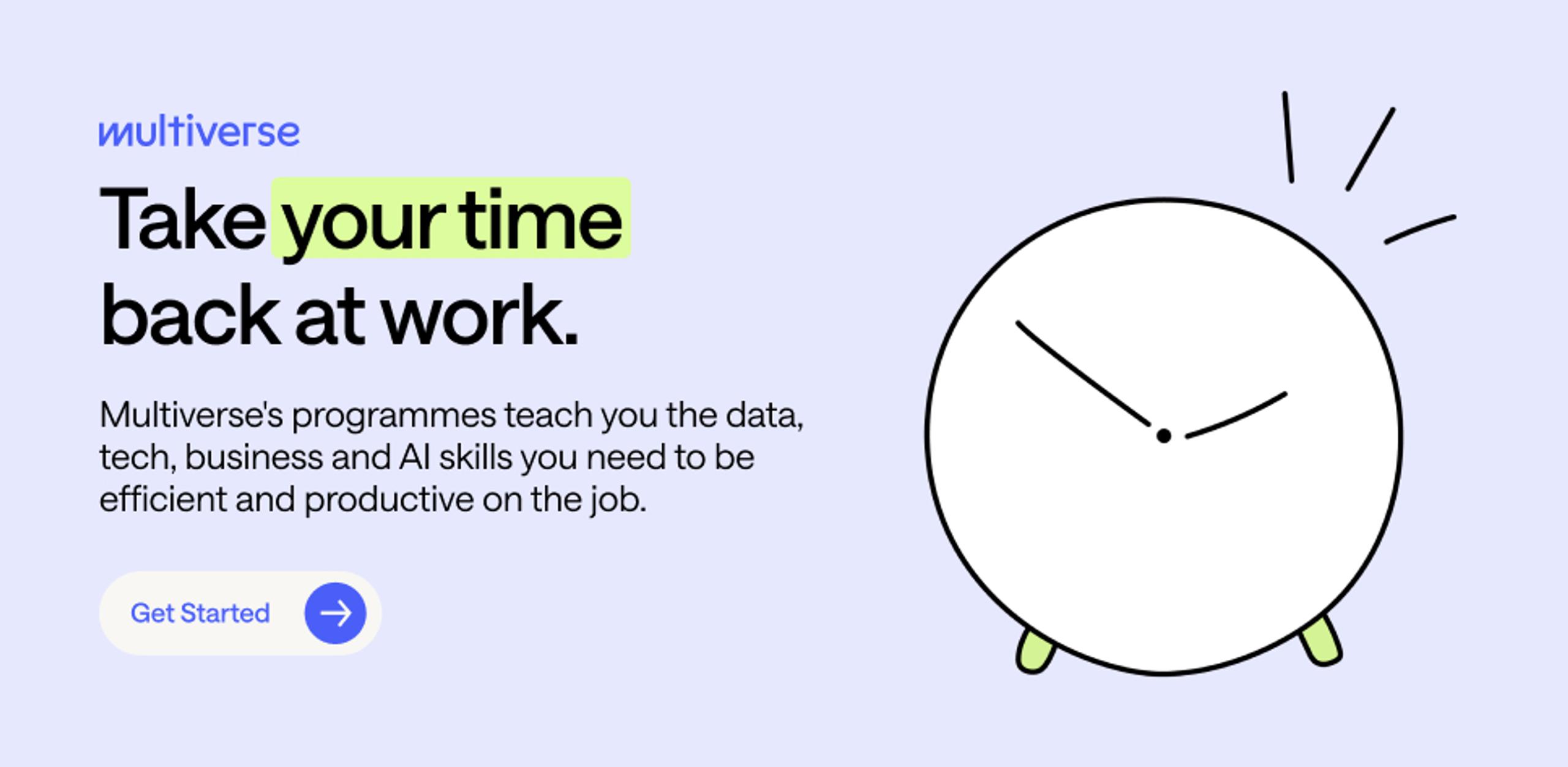If you’ve considered becoming a Data Scientist, you might be put off by how much maths is involved in data science. While it’s a core component of data science, you don’t need to know as much maths as you might think.
Let’s take a closer look at how professionals use maths for data science and how much you’ll need to know to pursue a career in this exciting field.
How do Data Scientists use maths?
A Data Scientist's primary role is to mine, examine, and make sense of data. Maths plays a role in each of these stages.
Data Scientists use mathematical skills to:
- Understand and use machine learning algorithms
- Analyse datasets from various sources
- Identify patterns in data
- Forecast trends and growth
Data Scientists also use mathematical functions to perform data analysis and apply machine learning techniques like clustering, regression, and classification.
Clustering
Clustering is a way to organise data into clusters or groups that share similarities with each other. It involves some calculus and statistics. A clustering algorithm organises data into these groups to identify trends and reveal insights at the surface level.
For example, a company with a large customer base can use clustering to segment customers based on their demographics or areas of interest. When you are promoting products, you can better personalise your marketing messages based on data points like customer location, behaviour, interests, and more.
Regression
Regression analysis is a way to measure how certain factors impact outcomes or objectives. In other words, it shows how one variable impacts another. It uses a combination of algebra and statistics.
Data Scientists use regression to make data-driven predictions and help businesses make better decisions. For example, they can use regression to forecast future sales or to predict if a company should increase the inventory of a product.
Classification
Data classification is the process of labelling or categorising data to easily store, retrieve, and use it to predict future outcomes. In machine learning, classification uses a set of training data to organise data into classes. For instance, an email spam filter uses classification to detect if an email is spam or not.
Foundations of data analysis
All data professionals need a solid grasp of essential mathematical concepts, but that’s only part of the skill set needed to analyse data effectively. The ability to work with diverse types of information and create data visualisations are also crucial for gaining meaningful insights.
Working with different data types
Data Analysts and Data Scientists handle a wide range of data types, including:
- Categorical data: Qualitative information that can be represented by a name or symbol, such as customer demographics and types of products
- Numerical data: Quantitative information, such as conversion rates and sales revenue
You should know how to use Structured Query Language (SQL) to manage categorical and numerical data. This language allows you to query, organise, and filter information in relational databases.
Data visualisation
Data Scientists often transform datasets into accessible graphic representations. These visualisations can reveal previously unnoticed patterns or anomalies in datasets. They also allow data professionals to communicate their findings with non-technical stakeholders.
Platforms like Microsoft BI and Tableau use machine learning models and mathematics to analyse data. They also have intuitive interfaces that allow you to design interactive dashboards and data visualisations. For example, you could use line graphs to represent economic trends over time.
You should also learn how to use data visualisation libraries in Python. Popular frameworks include Gleam, Matplotlib, and Plotly. They have built-in templates and themes that you can use to create polished visualisations quickly.
What types of maths do Data Scientists need to know?
Luckily, you don’t need to be a mathematician or have a Ph.D. in mathematics to be a Data Scientist. Data Scientists use three main types of maths—linear algebra, calculus, and statistics. Probability is another maths data scientists use, but it is sometimes grouped together with statistics.
Linear algebra
Some consider Linear Algebra the mathematics of data and the foundation of machine learning. Data Scientists manipulate and analyse raw data through matrices, rows, and columns of numbers or data points.
Datasets usually take the form of matrices. Data Scientists store and manipulate data inside them and they use linear algebra during the process. For example, linear algebra is a core component of data preprocessing. It’s the process of organising raw data so that it can be read and understood by machines.
At a minimum, Data Scientists should know matrices and vectors and how to apply basic algebra principles to solve data problems.
Calculus
Data Scientists use calculus to analyse rates of change and relationships within datasets. These maths skills help them understand how a change in one variable — such as changing customer preferences — affects another variable, like sales revenue.
Before you begin your data science journey, you should master the two main branches of calculus: differential and integral.
Differential calculus
Differential calculus studies how quickly quantities change. Data Scientists should learn its foundational concepts, including limits and derivatives. Python libraries like NumPy and SymPy can speed up this learning process by performing complex calculations efficiently.
Data professionals apply differential calculus to optimise machine learning models and functions. For instance, gradient descent calculates the error between the predicted and actual results. This method allows neural networks and other types of algorithms to adjust their parameters iteratively, reducing errors and improving performance.
Integral calculus
Integral calculus analyses the accumulation of quantities over a specific integral. To effectively apply this technique, you must understand definite and indefinite integrals. Familiarity with Python libraries like SciPy can also help you calculate integrals.
Data professionals use this branch of mathematics to solve many problems in data science, such as forecasting the demand for a product and analysing revenue. Machine learning algorithms also use integral calculus to calculate probability and variance.
Probability and statistics
Probability and statistics go hand in hand. Data professionals use these mathematical foundations to analyse information and forecast events.
Statistics is the branch of mathematics that collects and analyses large data sets to extract meaningful insights from them. Data Scientists use statistics to:
- Collect, review, analyse, and form insights from data
- Identify and translate data patterns into actionable business insights
- Answer questions by creating experiments, analysing and interpreting datasets
- Understand machine learning and predictive models
Here are a few examples of statistics principles you’ll need to know to break into the data science field:
- Descriptive statistics - Analyses a dataset to summarise its main characteristics, like mean and mode
- Inferential statistics - Extrapolates from known data to make predictions or generalisations about a larger population
- Linear regression - Predicts the relationship between an dependent variable and two or more independent variables
- Statistical experiments - Know how to create statistical hypotheses, do A/B testing and other experiments, and form conclusions
In contrast, probability is the likelihood that an event will occur. Data professionals use this method to analyse risk, forecast trends, and predict the outcomes of business decisions.
Data Scientists need to know these basics of probability:
- Distributions - Summarizes all the possible values in a dataset and the frequency with which they occur
- Statistical significance - Measures the likelihood that a relationship or result isn’t random
- Bayes' Theorem - A mathematical formula used to calculate the likelihood of an event based on prior knowledge and the probabilities of related events
- Hypothesis testing - Determines whether your assumptions about a particular population or dataset are supported by evidence
- Probability theory - Calculates the likelihood of different outcomes of random events or uncertain situations
Keep in mind that how much maths you need to know may also depend on your role. For example, a junior Data Analyst focuses more on analysing trends. Although they still need to know how to extract data and interpret information, they work less with complex mathematical concepts. Unless they need to work with machine learning algorithms, they’ll use maths for data science less than a senior-level Data Scientist.
This is more of an introduction than an exhaustive list of how much maths is involved in data science. If you are interested in learning data science and the maths that Data Scientists use, Multiverse offers a Data Fellowship and a Data & Insights for Business Decisions program.
Data Scientists roles: salary, job titles, and more
Modern businesses generate and collect enormous amounts of data, such as financial transactions, healthcare records, and social media posts. They need workers with hard data skills to analyse this information effectively and support data-driven decision-making.
In the UK, the surging demand for data professionals has far outpaced the available workforce. A study commissioned by the Department for Digital, Culture, Media and Sport(opens new window) found that UK businesses are seeking to fill 178,000 to 234,000 roles requiring hard data skills. However, 46% of the surveyed companies reported difficulty finding qualified candidates within the last two years.
This talent shortage has led many UK businesses to offer competitive salaries and other perks. According to Indeed, the average salary for Data Scientists in the UK is £51,000. To attract candidates with specialised data skills, employers may also offer hybrid or remote arrangements, generous leave policies, and additional benefits.
Professionals often begin their careers as junior Data Scientists or Analysts, but this field has many opportunities for advancement. Here are three job titles you could pursue as you gain experience:
Senior Data Scientist
A Senior Data Scientist leads long-term projects and supervises Junior Data Scientists. They also communicate findings to stakeholders and guide data-driven decision-making. For instance, a Senior Data Scientist might use machine learning algorithms to detect fraud and help business leaders develop new cybersecurity policies.
Salary:
- Starts at - £61,000
- Average base salary - £73,000
- Top earners make up to - £87,000
Source: Glassdoor
Machine Learning Engineer
A Machine Learning Engineer builds, deploys, and maintains machine learning applications. They use maths and data science to design and train machine learning models.
Salary:
- Starts at - £41,000
- Average base salary - £55,000
- Top earners make up to - £73,000
Source: Glassdoor
Data Architect
A Data Architect designs and maintains data structures, databases, and data pipelines. They’re responsible for integrating data from different sources so data flows smoothly throughout their organisation.
Salary:
- Starts at - £55,000
- Average base salary - £68,000
- Top earners make up to - £85,000
Source: Glassdoor
Boost your skills with comprehensive Data Scientist training
A strong understanding of maths is essential for machine learning and data science roles. It can help you solve problems, optimise model performance, and interpret complex data that answer business questions.
You don’t need to know how to solve every algebraic equation — Data Scientists use computers for that. However, you should become familiar with the principles of linear algebra, calculus, statistics, and probability. You don’t need to be an expert mathematician, but you should broadly enjoy maths and analysing numbers to pursue a data science career.
Multiverse’s Data Fellowship and Data & Insights for Business Decisions programs can help you learn the basic maths concepts you need to know. However, the focus is on how to apply those maths skills in data science.
The Data Fellowship guides you through the fundamental principles of data analysis, including identifying and solving real world problems with data. Our modules cover advanced analytics and statistical methods, data visualisation, data management, and other critical topics. You’ll sharpen your skills by participating in data analysis and statistics hackathons.
The Data & Insights for Business Decisions program teaches you how to transform raw data into meaningful insights. You’ll learn how to use popular data analytics tools — including Excel and PowerBI — to clean and manipulate data. The program also teaches you how to tell compelling stories with data and foster a data-driven culture in your organisation.
Upskillers don’t pay for tuition — programs are free. You actually get paid to work in a data role and learn while you complete the program. You’ll also start immediately applying your new skills by working on real projects for your employer, accelerating the learning process.
The first step is to apply here(opens new window). If accepted, you’ll start learning data science and get on-the-job training at a company that pays you for your time.










